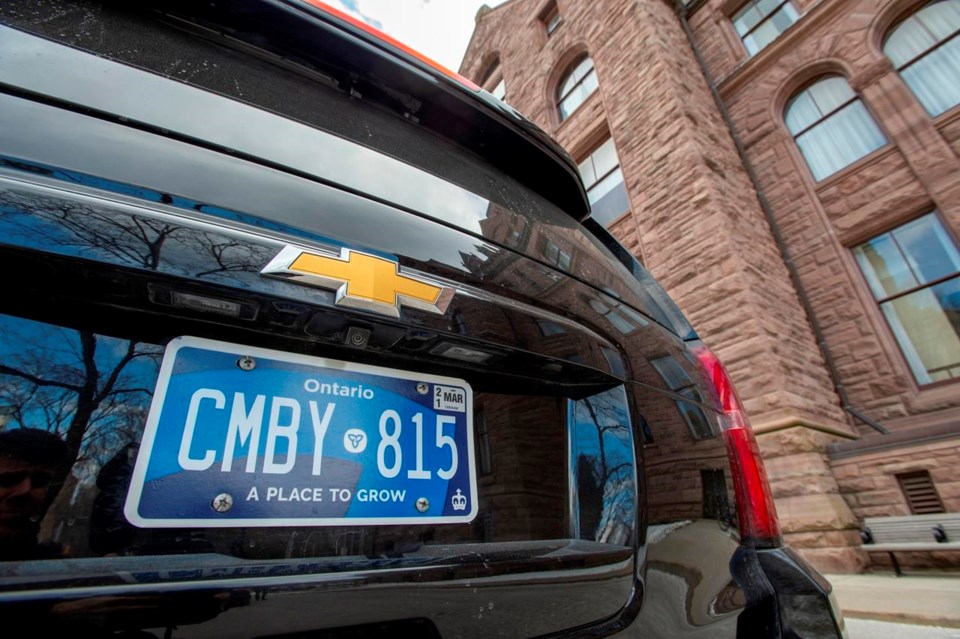TORONTO — Premier Doug Ford's government has a plan to get its blue licence plates off the roads, four years after discovering they are barely visible at night – and that plan is to sit back and wait.
The blue licence plates are set to simply disappear through attrition, The Canadian Press has learned.
That approach has been in place since November 2022, according to a senior government official not authorized to speak publicly about the matter.
The decision was not communicated publicly until the province confirmed its direction to The Canadian Press this week, after fighting the release of records through a freedom-of-information request for more than a year.
"After carefully considering potential options for implementing a dedicated collections program, the Ontario government hasdecided to naturally phase out existing blue licence plates," Matthew D'Amico, a press secretary for Public and Business Service Delivery Minister Todd McCarthy, wrote in a statement.
"While blue plates will continue to be valid, anyone wishing to exchange their blue licence plate can do so free of charge at a ServiceOntario centre."
The government's website still tells drivers that owners of blue licence plates "will receive instructions" on how to replace them "at a future date."
The province did explore various options, the senior government source said, including exchanging plates through the mail, but all of the options presented burdens to customers, risks such as theft, and costs of between $2.5 million and $3 million.
The government had committed to getting out of the blue licence plate mess with no additional cost to taxpayers, so ultimately the decision was made to go with natural attrition. There is no risk to public safety nor are there any plate readability issues for Highway 407 tolls, the source said.
Ford's Progressive Conservatives had announced the new look in their 2019 budget, to accusations of politicizing the plates by turning them a Tory blue.
Law enforcement officials raised concerns about the plates, as they are difficult to read in certain conditions, and officers need to be able to see plates legibly and clearly.
Joe Couto, a spokesperson for the Ontario Association of Chiefs of Police, previously said the chiefs wanted to see the plates off the roads "as soon as possible."
The government did not reach out to the chiefs for input on their natural phase out plan, but Couto said they will continue to provide input if requested.
"We’ve said to the government all along in terms of the blue plates that there are always concerns about the safety aspects of it and that’s all we’re concerned about," Couto said.
"How the government deals with the plates is completely up to them. If they choose evolution versus revolution, then so be it."
As of this month there are 124,000 blue licence plates on the road, the government said, or less than one per cent of active plates. About 193,000 were initially issued in 2020.
NDP critic Tom Rakocevic said in the meantime, blue plates on the roads continue to serve as a visual reminder of the mistakes and backtracking this government has had to do.
"Doing nothing is not a plan, and it's taken two years to announce their non-plan of doing nothing," he said. "They should be doing what's necessary to move forward and get these plates off the road."
In November 2022, The Canadian Press requested documents through freedom-of-information laws on plans to replace the blue plates, but the government denied it on several grounds, including that they were advice to government.
It also denied the documents on the grounds that their release would result in premature disclosure of a policy decision that has been reached but not yet announced.
"The ultimate policy decision regarding the specific options available to replace blue licence plates will be made available to the public in the future," the government wrote in August 2023 in submissions to the Information and Privacy Commissioner after The Canadian Press appealed.
"The Ministry determines policy decisions and announces them according to its own established timelines ... Disclosure of the information at issue in this appeal would prematurely disclose the Ministry’s pending policy decision, as the Ministry has decided that it does not yet want to release the policy decision."
Just two weeks after drivers first started receiving the blue plates, on Feb. 15, 2020, an off-duty police officer in Kingston, Ont., posted a picture of one at night in a well-lit parking lot showing it was "virtually unreadable."
The government and consumer services minister at the time initially insisted the new plates were fine, but soon after admitted there were problems and the province stopped issuing them in May of that year, reverting to the old white-and-blue design.
This report by The Canadian Press was first published Feb. 14, 2024.
Allison Jones, The Canadian Press




